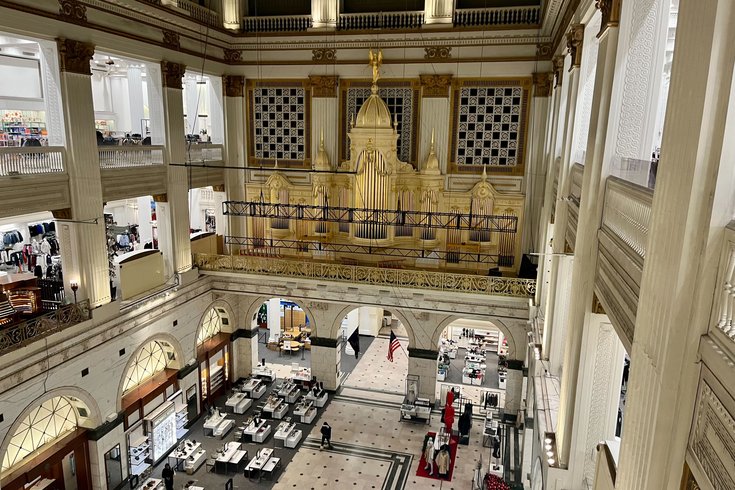
January 10, 2025
 Jon Tuleya/PhillyVoice
Jon Tuleya/PhillyVoice
The Wanamaker Grand Court, which contains the store's iconic organ and bronze Eagle statue, is among the few interiors protected by the Philadelphia Historical Commission. On Thursday, Macy's corporate headquarters announced the Center City store would be closing.
When Macy's makes its exit from the Wanamaker Building, it'll take with it racks of clothing, shoes and perfume. But two key features of the space are staying behind: the Wanamaker Grand Court Organ and Eagle sculpture.
Both objects are protected by the Philadelphia Historical Commission. The Eagle statue was added to the city's register of historic places in 2001, while the building's entire "grand court" — the seven-story open interior space that includes both the organ and Eagle — was added in 2018. That means any new building permits would have to go through the commission.
"(With) permits to alter, construct, build, whatever, this historical commission is going to be the first stop of review for that," said Bruce Bohri, a public relations specialist for the city's planning and development department. "Their approval is what is necessary for moving forward and their review process includes the architectural committee of the historical commission and the commission itself."
The designation protects not only the 122-foot-long and 150-foot-high space that runs from the building's floor to ceiling, but objects and architectural elements within the atrium. The Wanamaker Grand Court Organ, the largest functional organ in the world, faces out to the front of the south gallery wall. The 10-foot bronze Eagle statue, which sits atop a stone base, is located on the space's central aisle. The court also includes white marble walls with green marble accents, gilded Corinthian columns and waterleaf moldings. A bronze star on the ground floor marks the spot where President William H. Taft formally dedicated the original John Wanamaker Department Store in 1911. He was the only sitting president to ever dedicate a department store.
Wanamaker's, as the store was eventually dubbed, was one of the first modern American department stores. Its founder and namesake spared little expense in its construction, tapping prominent Beaux Arts architect Daniel H. Burnham to design the building and shopping the 1904 World's Fair in St. Louis for decor. That was where he found and purchased the Eagle and 10,000-pipe organ, which took up 13 railroad boxcars on its journey to Philadelphia. The instrument expanded over the years to feature 28,500 pipes, which entertain shoppers with concerts at noon and 5:30 p.m. Mondays through Saturdays. (Friends of the Wanamaker Organ, which sponsors and supports the object's preservation, said in a statement that these performances would continue until Macy's closing.)
This significance earned the space its city protections, but alterations aren't out of the question. As Bohri explained, the historical commission approves permits that satisfy preservations standards and "work to protect and preserve character-defining features that are identified in the nomination."
"The changes are about stewarding these resources into the future," he said. "It manages changes, it doesn't necessarily prevent change."
Follow Kristin & PhillyVoice on Twitter: @kristin_hunt
| @thePhillyVoice
Like us on Facebook: PhillyVoice
Have a news tip? Let us know.